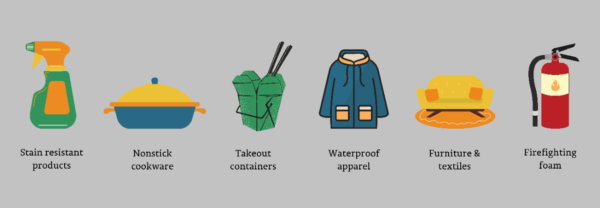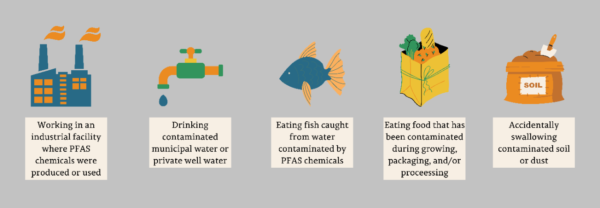PFAS offer desirable consumer benefits and are added to numerous consumer products.
PFAS are excellent at repelling oil and water and have high thermal stability. Water repellency, stain resistance and nonstick performance are important consumer benefits, whereas lubrication, and foam stabilization (in some firefighting foams) are important industry benefits.
Part 1 of this series provided a PFAS definition and explained how they are hazardous. This post is about products that may contain PFAS and common exposure routes.
PFAS are used on the following types of products
The picture from the Department of Environment and Conservation shows some product categories that contain PFAS. Another excellent resource is Green Science and Policy Six Classes series.
Product categories include:
 Textiles: This group includes carpets and rugs, upholstery and home products such as napery. (Apparel and footwear warrants its own category)
Textiles: This group includes carpets and rugs, upholstery and home products such as napery. (Apparel and footwear warrants its own category)
PFAS protect against stains, and make products look new for longer, both important consumer benefits, especially for high priced textile products. PFAS-free alternatives exist, although they do not repel oil-based stains.
Cookware: Non-stick cookware is a fantastic consumer benefit. Cookware treated with DuPont Teflon® and other PFAS make it easier to cook food and clean dirty pots and pans. When Teflon® cookware was introduced in the 1960’s, it transformed cooking due to its heat resistance and easy to clean benefits. Cast iron works too!
Food packaging and food wares: PFAS-treated paper packaging designed for high fat food, such as microwavable popcorn and dry pet food bags, prevents grease marks and paper tears, ultimately improving durability. Clean Production Action and the Center for Environmental Health, offer plenty of safer GreenScreen Certified alternatives.
Apparel and Footwear: Durable water repellency is an important consumer benefit for outdoor apparel and footwear because it keeps the wearer dry. Stain repellency, more applicable to school uniforms, workwear and casual apparel resist water and oil based stains.
Electronics: Water-resistant mobile phones are treated with PFAS, including the insulated wiring, circuit boards, semiconductors, and the screen coatings.
Personal care products: Although not shown on the diagram, mascara, lipstick, shampoo, nail polish, sunscreen, some dental floss, and shaving cream may contain PFAS.
Other: The Guardian and OECD lists numerous products that are treated with PFAS. These include, but are not limited to, artificial turf, ammunition, guitar strings and piano keys and toner and printing ink.
How we are exposed to them
We eat PFAS. We drink PFAS and our skin absorbs PFAS.
The picture, also from the Department of Environment and Conservation shows some of the exposure pathways of PFAS.

The largest sources of PFAS pollution is firefighting foam and manufacturing.
Most contamination is found near airports, ports, military bases, and local fire districts.
PFAS pollutants enter and contaminate the water supply, which then exposes the public. However there are more exposure routes than just the water supply.
PFAS may be found in:
Drinking water: The EWG provides and updates a map that shows PFAS contamination in public and private drinking water systems in the U.S. Since August 2021, 2854, sites are contaminated with PFAS. In this case, they are directly ingested via drinking.
Food: Because some PFAS bioaccumulate and biomagnify, they build up in food sources including crops, seafood, and livestock, and we eat that food. Food packaging, treated with PFAS, contaminates food, which is another exposure pathway.
Indoor air and dust: PFAS are often added to apparel, footwear, carpets, drapes, and furniture, where they continuously shed into air and dust. In this case, we inhale PFAS.
Personal care products: Make-up and creams that contain PFAS enter the body mostly through the skin. Shampoo and other rinse away products enter through the skin, or will be washed away into the environment.
Do you need help with your PFAS elimination strategy, chemical management or sustainability?
For help with sustainability, circularity and chemicals, contact Amanda Cattermole at (415) 412 8406 or Amanda@cattermoleconsulting.com. We can help you develop powerful solutions to protect your company and brand reputation.
Tips and Insights contains information to help you make informed sustainability decisions. Each post highlights a particular topic that you may want to consider for your business.

